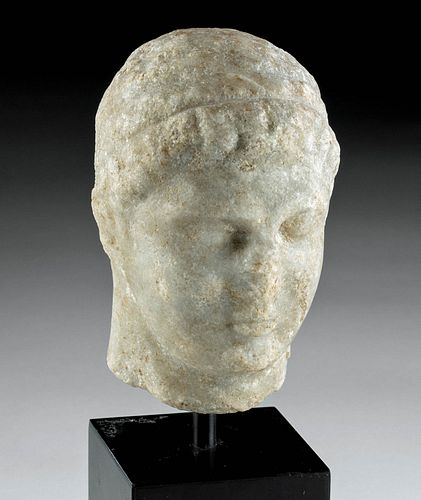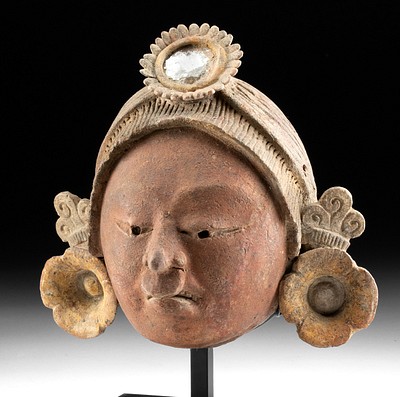Roman Julio-Claudian Marble Head, ex-Arte Primitivo
Lot 18
About Seller
Artemis Fine Arts
686 S Taylor Ave, Ste 106
Louisville, CO 80027
United States
Selling antiquities, ancient and ethnographic art online since 1993, Artemis Gallery specializes in Classical Antiquities (Egyptian, Greek, Roman, Near Eastern), Asian, Pre-Columbian, African / Tribal / Oceanographic art. Our extensive inventory includes pottery, stone, metal, wood, glass and textil...Read more
Estimate:
$2,400 - $3,600
Absentee vs Live bid
Two ways to bid:
- Leave a max absentee bid and the platform will bid on your behalf up to your maximum bid during the live auction.
- Bid live during the auction and your bids will be submitted real-time to the auctioneer.
Bid Increments
| Price | Bid Increment |
|---|---|
| $0 | $25 |
| $300 | $50 |
| $1,000 | $100 |
| $2,000 | $250 |
| $5,000 | $500 |
| $10,000 | $1,000 |
| $20,000 | $2,500 |
| $50,000 | $5,000 |
| $100,000 | $10,000 |
| $200,000 | $20,000 |
About Auction
By Artemis Fine Arts
Jul 14, 2022
Set Reminder
2022-07-14 10:00:00
2022-07-14 10:00:00
America/New_York
Bidsquare
Bidsquare : Exceptional Antiquities Ethnographica Fine Art
https://www.bidsquare.com/auctions/artemis-gallery/exceptional-antiquities-ethnographica-fine-art-9692
Museum-worthy examples of classical antiquities (Egyptian, Greek, Roman, Near Eastern), Viking, Far East / Asian, Pre-Columbian, African / Tribal, Oceanic, Native American, Spanish Colonial, Fossils, Ancient Jewelry, Fine / Visual Arts, so much more! Artemis Fine Arts info@artemisgallery.com
Museum-worthy examples of classical antiquities (Egyptian, Greek, Roman, Near Eastern), Viking, Far East / Asian, Pre-Columbian, African / Tribal, Oceanic, Native American, Spanish Colonial, Fossils, Ancient Jewelry, Fine / Visual Arts, so much more! Artemis Fine Arts info@artemisgallery.com
- Lot Description
Roman, Imperial Period, Julio-Claudian Period, ca. 1st Century BCE to 1st Century CE. An impressive marble head of a male youth with idealized features as opposed to the veristic representations popular during the Republican period. Notice that the sculptor presents this individual's visage with clean-shaven skin and handsome characteristics, such as deep-set eyes, a sharp brow, a petite nose, cupid's bow lips, high cheekbones, and closely cropped, wavy hair crowned by a fillet. The classicizing features and treatment of the eyes suggest that the head was created during the Julio-Claudian Period. Size: 2.2" W x 3.6" H (5.6 cm x 9.1 cm); 6.6" H (16.8 cm) on included custom stand.
It is possible that this youth was actually a portrait of a young regal. Augustan and Julio-Claudian portraits emphasized the beauty and youth of their leaders. Augustus set this precedent which was subscribed to by imperial portraiture until the reign of Constantine the Great. The Romans' idealizations of emperor's images were designed to present visual associations with their predecessors - serving as a means of legitimatizing the emperor's authority. For instance, according to the Metropolitan Museum of Art's Heilbrunn Timeline essay entitled "Roman Portrait Sculpture: The Stylistic Cycle," Tiberius' portraits presented an uncanny resemblance to those of Augustus, even though the two were not related. The author states, "Tiberius (r. 14-37 A.D.) (1994.230.7) was not actually related to Augustus, but his portraits portray a remarkable, and fictionalized, resemblance that connected him to the princeps and helped substantiate his position as successor. Even Tiberius' successor Caligula (r. 37-41 A.D.) (14.37), who had no interest in continuing Augustus’ administrative ideals and was much more concerned with promoting his own agenda, followed the Augustan and Tiberian portrait tradition of classical and idealized features that carried a strong 'family' resemblance."
Provenance: East Coast collection, New York Gallery, New York City, New York, USA, acquired before 2010; ex-Arte Primitivo, New York, New York, USA
All items legal to buy/sell under U.S. Statute covering cultural patrimony Code 2600, CHAPTER 14, and are guaranteed to be as described or your money back.
A Certificate of Authenticity will accompany all winning bids.
PLEASE NOTE: Due to recent increases of shipments being seized by Australian & German customs (even for items with pre-UNESCO provenance), we will no longer ship most antiquities and ancient Chinese art to Australia & Germany. For categories of items that are acceptable to ship to Australia or Germany, please contact us directly or work with your local customs brokerage firm.
Display stands not described as included/custom in the item description are for photography purposes only and will not be included with the item upon shipping.
#172726Fragment of a larger piece. Losses to nose and base of neck. Expected surface wear with some chipping to back of head, as well as abrasions and softening of detail. Otherwise, very nice with light encrustations in recessed areas.Condition
- Shipping Info
-
All shipping is handled in-house for your convenience. Your invoice from Artemis Gallery will include shipping calculation instructions. If in doubt, please inquire BEFORE bidding for estimated shipping costs for individual items.
-
- Buyer's Premium



 EUR
EUR CAD
CAD AUD
AUD GBP
GBP MXN
MXN HKD
HKD CNY
CNY MYR
MYR SEK
SEK SGD
SGD CHF
CHF THB
THB













